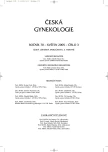Laparoscopy in Chronic Pelvic Pain – a Prospective Clinical Study
Authors:
P. Žúbor; N. Szunyogh; S. Galo; K. Biringer; K. Dókuš; J. Višňovský; J. Danko
Authors‘ workplace:
Gynekologicko-pôrodnícka klinika JLF UK, Martin, prednosta prof. MUDr. J. Danko, CSc.
Published in:
Ceska Gynekol 2005; 70(3): 225-231
Category:
Original Article
Overview
Objective:
The aim of this study was to analyze the incidence, causes and management in women with chronic pelvic pain and to evaluate the role of laparoscopy.
Design:
A prospective non-randomized clinical trial on 86 women with chronic pelvic pain.
Setting:
Clinic of Gynecology and Obstetrics, JMF CU Martin, Slovak Republic.
Methods:
A prospective clinical trial was performed on 86 patients with chronic pelvic pain, who have undergone laparoscopy from March 2003 to March 2004. Only patients with a pain history of at least 6 month were enrolled into this trial. Specific patient’s history characteristics, laparoscopic and cytologic findings were reviewed and analyzed (pain interval, organic findings, preoperative ultrasound examination, previous surgical intervention, oral contraceptive usage, patient’s medical history, menstrual cycle regularity, age, presence of dysmenorrhea). In all women, laparoscopy was performed under general anesthesia.
Results:
During the study we have performed 309 diagnostic laparoscopic examinations, from which 86 (27.8%) were done due to chronic pelvic pain. The mean patient’s age was 35.8 years (19–56). The mean parity was 1.6, ranging from 0–5. Pelvic organ pathology was present in 88.4% of the patients. The most frequent finding was endometriosis (31.4%). According to revised criteria of the American Fertility Society the presence of first, second, third and fourth stage of endometriosis was 55.6, 25.9, 11.1 and 7.4%, respectively. The most frequent occurrence of endometriotic lesions were on ligamenta sacrouterina (21.4%) and plica vesicouterina (19.0%). Pelvic adhesions, myomas, pelvic varicosities and chronic inflammatory process were present in 25.6, 15.1, 9.3 and 3.5% of the cases, respectively. No somatic origin of pain was identified at laparoscopy in 11.6% of patients. Preoperative ultrasonic examination with pelvic pathology findings were performed in 36 patients, and laparoscopy correlated with ultrasonographic findings in 31 (86.1%) cases. The average pain duration was 11.5 months (6–28) with the majority among women with history of previous surgical intervention (48.8%) and parturated women.
Presence of pain was most common among women after 31 years of age. Predominantly, cytology examination of biological materials (peritoneal fluid, cyst fluid) revealed an increased histiocytic reaction in coincidence with chronic inflammation process in 31.6%.
Conclusion:
Invasive laparoscopy in chronic pelvic pain pertains to one of the most important examination procedures for its high specificity and sensitivity. Laparoscopy can reveal organic causes of pelvic pathology in 60% of cases with the possibility of following treatment. Our combined effort should stop the progression of such pathology leading to possible morphologic, functional and psychological alteration, especially among young women in fertile age. Today, endometriosis still remains the main cause of chronic pelvic pain in high percentage rate.
Key words:
chronic pelvic pain, laparoscopy, endometriosis
Labels
Paediatric gynaecology Gynaecology and obstetrics Reproduction medicineArticle was published in
Czech Gynaecology

2005 Issue 3
Most read in this issue
- Nalbuphine in Obstetrical Analgesia
- Premature Separation of the Placenta – Etiology and Risk Factors
- „Mixed“ and „Miscellaneous“ Vulvovaginitis: Diagnostics and Therapy of Vaginal Administration of Nystatin and Nifuratel
- Metastasing and Relapsing „Low Grade“ Adenosquamous Metaplastic Breast Cancer – is There a Really Indolent Lesion? A Description of Three Cases and Review of Literature
